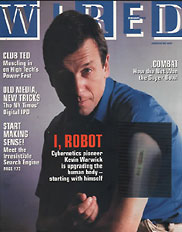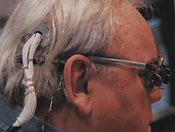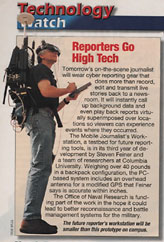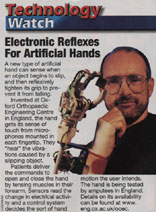Roots of Cybernetics
The term cybernetics
was coined by Norbert Wiener in 1948 in a book of the same name, and is
essentially defined as the science of communication and control. More
specifically, it is "the theoretical study of communication and control
processes in biological, mechanical, and electronic systems, especially
the comparison ofthese processes in biological and artificial systems."
It's largely about how we exchange information with and through machines,
and who initiates controlin these exchanges. It's about the interface,
about the mode in which understanding is transferred back and forth to
machines, between machines, and through machines to other humans. In the
introduction to the Cyborg  Handbook,
the editors define cybernetics as "the common language of man and machine."
Do you talk to your machines? I do... I'm not sure they always understand
me, or me them, but we'll continue negotiating this understanding well
into the future.
Handbook,
the editors define cybernetics as "the common language of man and machine."
Do you talk to your machines? I do... I'm not sure they always understand
me, or me them, but we'll continue negotiating this understanding well
into the future.
The term cyborg was coined in 1960 by Manfred Clynes as a contraction
of "cybernetic organism", in other words,systems of control and communication
embedded in biology. Cyborgs are beings at the "intersection of nature
and culture", born of the biological world, enhanced by our constructed
technologies.
Popular images of the cyborg abound in our technological
landscape. What comes first to mind when you think "cyborg"? "Humachines"
have captured our cultural imagination.  Movies
like the Terminator feature creatures of organic flesh on the outside,
robotic skeleton on the inside; and not just science fiction, but also
popularized scientific research like
Movies
like the Terminator feature creatures of organic flesh on the outside,
robotic skeleton on the inside; and not just science fiction, but also
popularized scientific research like Kevin Warwick's embedded microchips. For those of you not familiar with
his work, he had a passive transponder implanted under his skin in 1999,
surgically inserted into his body, and that transponder acted as a remote
activator for devices in the building where he works. So for instance
he could walk up to a door and it would open for him, walk into a room
and the lights would come on. His current research involves the embedded
chip integrated into his nerve bundles. So while most people still view
cybernetics as futuristic fiction, we are beginning to see everyday examples
all around in our high tech society. Every month in magazines like Wired
and Popular Mechanics, there are reports of technology developments which
produce cyborgs: prosthetic hands, a remote journalist, the cybernetic
vision device that plugs into the optic nerve of the blind. Yes, that's
a brain socket connection to the machine. Sounds a lot like science fiction,
if anyone has read William Gibson or other cyberpunk authors, you might
be familiar with this idea of plugging technology into the brain. Well,
it's coming. It's on it's way.
Kevin Warwick's embedded microchips. For those of you not familiar with
his work, he had a passive transponder implanted under his skin in 1999,
surgically inserted into his body, and that transponder acted as a remote
activator for devices in the building where he works. So for instance
he could walk up to a door and it would open for him, walk into a room
and the lights would come on. His current research involves the embedded
chip integrated into his nerve bundles. So while most people still view
cybernetics as futuristic fiction, we are beginning to see everyday examples
all around in our high tech society. Every month in magazines like Wired
and Popular Mechanics, there are reports of technology developments which
produce cyborgs: prosthetic hands, a remote journalist, the cybernetic
vision device that plugs into the optic nerve of the blind. Yes, that's
a brain socket connection to the machine. Sounds a lot like science fiction,
if anyone has read William Gibson or other cyberpunk authors, you might
be familiar with this idea of plugging technology into the brain. Well,
it's coming. It's on it's way.



Today's Cyborgs |